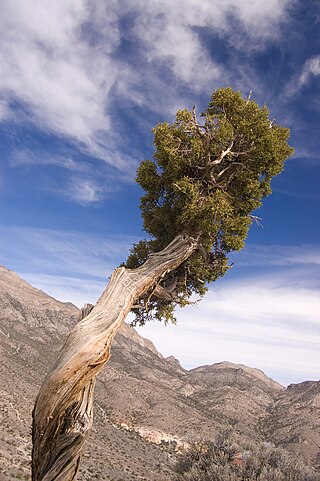
Junipers are coniferous trees and shrubs in the genus Juniperus of the cypress family Cupressaceae. Depending on the taxonomy, between 50 and 67 species of junipers are widely distributed throughout the Northern Hemisphere, from the Arctic, south to tropical Africa, throughout parts of western, central and southern Asia, east to eastern Tibet in the Old World, and in the mountains of Central America. The highest-known juniper forest occurs at an altitude of 4,900 metres (16,100 ft) in southeastern Tibet and the northern Himalayas, creating one of the highest tree lines on earth.

Juniperus communis, the common juniper, is a species of small tree or shrub in the cypress family Cupressaceae. An evergreen conifer, it has the largest geographical range of any woody plant, with a circumpolar distribution throughout the cool temperate Northern Hemisphere.

Juniperus virginiana, also known as eastern redcedar, red cedar, Virginian juniper, eastern juniper, red juniper, and other local names, is a species of juniper native to eastern North America from southeastern Canada to the Gulf of Mexico and east of the Great Plains. Further west it is replaced by the related Juniperus scopulorum and to the southwest by Juniperus ashei. It is not to be confused with Thuja occidentalis.

Juniperus ashei is a drought-tolerant evergreen tree, native from northeastern Mexico and the south-central United States to southern Missouri. The largest areas are in central Texas, where extensive stands occur. Ashe juniper grows up to 10 metres tall, and over time can reach 15 m (49 ft), and provides erosion control and year-round shade for wildlife and livestock.
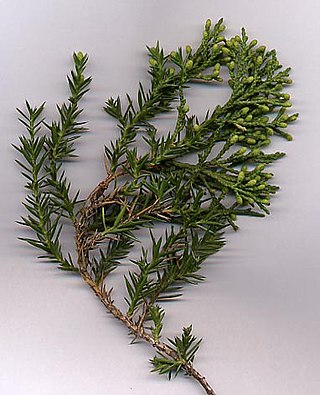
Juniperus chinensis, the Chinese juniper is a species of plant in the cypress family Cupressaceae, native to China, Myanmar, Japan, Korea and the Russian Far East. Growing 1–20 metres tall, it is a very variable coniferous evergreen tree or shrub.
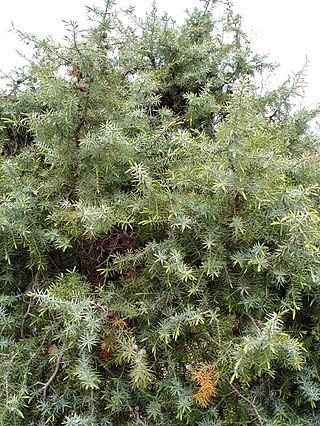
Juniperus oxycedrus, vernacularly called Cade, cade juniper, prickly juniper, prickly cedar, or sharp cedar, is a species of juniper, native across the Mediterranean region, growing on a variety of rocky sites from sea level. The specific epithet oxycedrus means "sharp cedar" and this species may have been the original cedar or cedrus of the ancient Greeks.

Juniperus osteosperma is a shrub or small tree native to the southwestern United States.

Juniperus californica, the California juniper, is a species of juniper native to southwestern North America.

Juniperus occidentalis, known as the western juniper, is a shrub or tree native to the Western United States, growing in mountains at altitudes of 800–3,000 meters (2,600–9,800 ft) and rarely down to 100 m (330 ft). It is listed as Least Concern on the IUCN Red List because it is a widespread species with an increasing population.
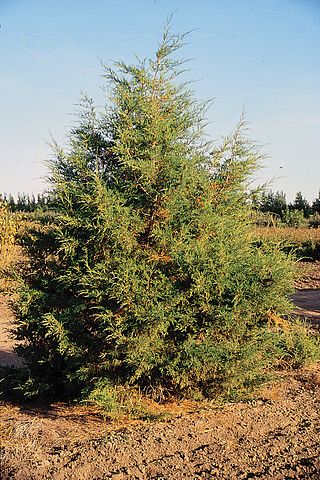
Juniperus scopulorum, the Rocky Mountain juniper, is a species of juniper native to western North America, from southwest Canada to the Great Plains of the United States.

Juniperus sabina, the savin juniper or savin, is a species of juniper native to the mountains of central and southern Europe and western and central Asia, from Spain to eastern Siberia, typically growing at altitudes of 1,000–3,300 metres.

Juniperus thurifera is a species of juniper native to the mountains of the western Mediterranean region, from southern France across eastern and central Spain to Morocco and locally in northern Algeria.
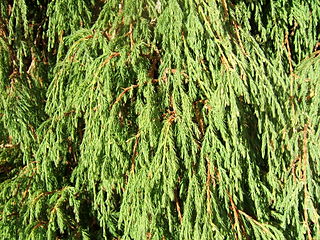
Juniperus recurva, commonly named the Himalayan juniper or drooping juniper, is a juniper native to the Himalaya, from northern Pakistan, through India, Nepal and Bhutan, to western Yunnan in southwestern China. It grows at altitudes of 3,000–4,000 metres.
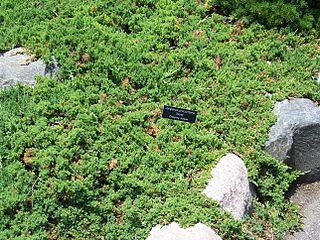
Juniperus procumbens is a species of shrub in the cypress family Cupressaceae, native to Japan. This low-growing evergreen conifer is closely related to the Chinese juniper, Juniperus chinensis, and is sometimes treated as a variety of it, as J. chinensis var. procumbens.

Juniperus squamata, the flaky juniper, or Himalayan juniper is a species of coniferous shrub in the cypress family Cupressaceae, native to the Himalayas and China.

Juniperus procera is a coniferous tree native to mountainous areas in Africa and the Arabian Peninsula. It is a characteristic tree of the Afromontane flora.

Juniperus deppeana is a small to medium-sized tree reaching 10–15 metres in height. It is native to central and northern Mexico and the southwestern United States.
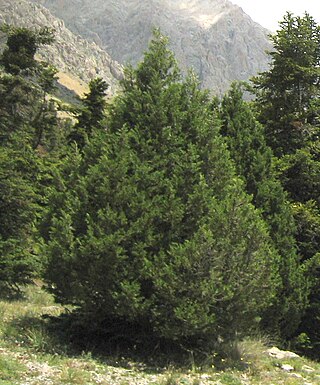
Juniperus foetidissima, with common names foetid juniper or stinking juniper, is a juniper tree species in the family Cupressaceae.

Juniperus pseudosabina, the Turkestan juniper or dwarf black juniper is a species of juniper.

Juniperus tibetica, the Tibetan juniper, is a species of juniper, native to western China in southern Gansu, southeastern Qinghai, Sichuan, and Tibet Autonomous Region, where it grows at high to very high altitudes of 2,600–4,900 metres. This species has the highest known elevation treeline in the northern hemisphere.























